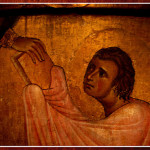We run our website the way we wished the whole internet worked: we provide high quality original content with no ads. We are funded solely by your direct support. Please consider supporting this project.
How do you respond to Bart Ehrman’s book, “Misquoting Jesus”?
Question: I just read Bart Ehrman’s book Misquoting Jesus and it’s sort of rocked my world. How can we believe the Bible is God’s inerrant Word when we don’t even know what the original Bible said?
Answer: I actually went to graduate school with Bart Ehrman (at Princeton). We used to smoke pipes together up in the smokers’ lounge at Princeton Seminary. I really liked him. He was “edgy.” But it was clear, even back then, that he had a sort of chip on his shoulder about the fundamentalism he’d been raised in. I suspect this chip on his shoulder biases his scholarship a bit.
Now, I’ll start by expressing a point of agreement with Ehrman’s work. What seemed to erode Ehrman’s faith in Seminary, so far as I could tell, was the challenge textual variations posed to a belief in “inerrancy” (the belief that every word of the Bible has to be without error). How can anyone hold that it’s important that every word of the Bible is “without error” when we don’t even know what many of the original words even were?
Ehrman’s got a strong point here. If we think it’s important to believe that the Bible is without error, we set ourselves up for the very problem Ehrman ran into — and now exposes with his book. The word “inerrant” only has meaning if we have “inerrant” copies of the Bible to measure “error” up against — and that is precisely what Bart shows we don’t have. (Though this is nothing new really. Textual critics have been saying this for centuries). For me, it’s enough to hold that the Bible is “inspired” and generally historically “trustworthy.”
Having said that, there’s six brief observations I’d make about Ehrman’s work.
1) The book is a good introduction to the science of textual criticism. But some of Bart’s conclusions seem to outrun the evidence — even the evidence that he himself cites. Consider that Bart is looking at the same evidence every other textual critic looks at. He’s “discovered” nothing new. Yet, hardly anyone goes to the extreme Bart goes to in his conclusions.
One of Ehrman’s teachers, whom I also knew at Princeton, was Bruce Metzger. Metzger came to much more conservative conclusions than Ehrman — yet looked at the exact same evidence. The vast majority of textual critics are closer to Metzger than Ehrman.
2) The way Bart phrases things has an “alarmist” ring to it. I think he just likes to shake things up. For example, he makes quite deal over the thousands upon thousands of variations there are in the textual tradition. Uninformed lay readers could easily get the impression that almost every verse in the New Testament is in question.
Well, Ehrman is technically correct that there are thousands upon thousands of textual variations. But it’s also the case that the vast majority of these thousands of variations are simply copies of copies of copies, etc… In other words, once a variation enters the textual tradition, it gets copied over and over and over again. Ehrman sometimes seems to count each of these copies as though it was a distinct variation when it’s not.
3) Even the most liberal textual critics grant that at least 95% of the text of the New Testament is not in question. (The standard estimates I’ve read are closer to 98%). And the 5% or less about which there may be some doubt do not affect anything of substance in the faith. Not only this, but most of this 5% is not totally in question, for scholars assign probabilities to this material. In other words, a text may be (say) 80% certain — but so long as it’s not 100%, it’s put in the “questionable” category.
4) We have over 25,000 manuscript pieces of textual evidence to help us reconstruct the originals of the New Testament documents, and much of this evidence is very early. This is by far and away the best attested work in history. The next closest ancient document in terms of textual support is Homer’s Iliad which has about 900 manuscript pieces of evidence to support it. My point is that if we’re going to seriously question whether we can trust that what we have today is a reasonably close approximation to the New Testament, we should distrust our copies of every ancient author.
5) Bart’s book makes “mountains out of mole hills” all over the place. For example, he makes a big deal over the fact that 1 John 5:7 , which speaks about the Trinity, wasn’t in the original Bible. In fact, it was inserted by Erasmus in the 16th century. But so what? The doctrine of the Trinity has never been based on THAT verse — obviously, since the doctrine of the Trinity was articulated in the first four centuries of church history and this verse wasn’t in the Bible these early fathers were using.
Not only this, but hardly any scholars have taken I John 5:7 seriously for the past four hundred years! That’s why it’s omitted in all translations of the Bible except the King James Version.
6) Bart may (or may not) have substantiated his claim that sometimes intentional alterations were made in the text to make a passage sound more “orthodox.” Even if we grant this (and many textual critics would not), it doesn’t affect much.
First, if we throw out all the texts about which there is some question — including those that may have been intentionally altered — it wouldn’t affect our general estimation of the reliability of the New Testament documents and wouldn’t affect anything important to the faith.
Second — and this is very important — in the ancient world written texts were regarded as expressions of an oral tradition, and it was understood that it’s okay to slightly modify oral traditions to address new issues that have arisen in the community. So even if certain texts were altered slightly (and all the alleged alterations are in fact slight), it doesn’t mean there was anything sinister going on. This is what people expected to be done.
So, if you ask me, Ehrman’s book need not rock anyone’s world. It perhaps challenges those who put a lot of stake in a particular view of “inerrancy,” but in my view it was ill advised to put much stock in that view in the first place.
Category: Q&A
Tags: Bible, New Testament, Q&A
Topics: Biblical Reliability
Related Reading

What is the significance of Revelation 22:18?
“If anyone takes away from the words of the book of this prophecy, God will take away that person’s share in the tree of life and in the holy city…” For God to “take away” something he must have given it first. But, as with the previous verse, if God foreknew from whom he would…

What is the significance of Numbers 11:1–2?
The Lord was in the process of judging Israel by fire when Moses interceded in prayer “and the fire abated.” A common sense reading of the verse suggests that the fire would have continued had Moses not prayed. Scripture is full of examples of God changing his plans in response to human prayer and repentance.…

How do you respond to Galatians 1:15–16?
“…when God, who had set me apart before I was born and called me through his grace, was pleased to reveal his Son to me…I did not confer with any human being…” As with Jeremiah (Jer. 1:5), John the Baptist (Luke 1:13–17) and other God-ordained prophets, Paul was aware that God had decided on a…

Why Bart Ehrman Doesn’t Have to Ruin Your Christmas (Or Your Faith) Part 5
This is the fifth of several videos Greg put together to refute Bart Ehrman’s claims published in the article What Do We Really Know About Jesus? In this segment, Greg points out that none of Bart’s material are new discoveries. Even the most conservative scholars in this field are aware of them, and yet, none of them…

Part 3: Disarming Flood’s Inadequate Conception of Biblical Authority
Image by Ex-InTransit via Flickr In this third part of my review of Derek Flood’s Disarming Scripture I will offer a critique of his redefined conception of biblical inspiration and authority. I will begin by having us recall from Part I that Flood holds up “faithful questioning” over “unquestioning obedience” as the kind of faith that Jesus…

God in Our Image
zen Sutherland via Compfight We came across this piece written by Jonathan Storment earlier this month and we had to share it here. The title of the piece is Everyday Idolatry: My God. He does a great job of outlining the ways that we twist God into whatever we need him to be to prop up…
